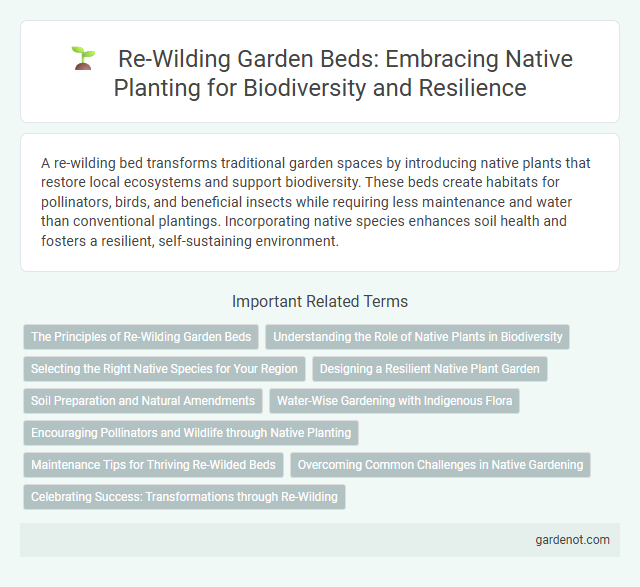A re-wilding bed transforms traditional garden spaces by introducing native plants that restore local ecosystems and support biodiversity. These beds create habitats for pollinators, birds, and beneficial insects while requiring less maintenance and water than conventional plantings. Incorporating native species enhances soil health and fosters a resilient, self-sustaining environment.
The Principles of Re-Wilding Garden Beds
Re-wilding garden beds involves restoring native plant communities by prioritizing biodiversity, soil health, and natural ecosystem processes. This approach encourages planting indigenous species that support local wildlife, improve habitat connectivity, and require minimal maintenance. Emphasizing ecological balance, re-wilding promotes resilience against pests and climate variability through diverse, self-sustaining plantings.
Understanding the Role of Native Plants in Biodiversity
Native plants in re-wilding beds play a critical role in enhancing biodiversity by providing essential habitats and food sources for local wildlife, including pollinators, birds, and insects. These plants support intricate ecological networks by maintaining soil health, improving water retention, and fostering native microbial communities. Incorporating diverse native species promotes resilience against invasive species and climate fluctuations, ensuring sustainable ecosystem restoration.
Selecting the Right Native Species for Your Region
Choosing native plants that thrive naturally in your specific climate and soil conditions enhances biodiversity and supports local wildlife in re-wilding beds. Researching regional plant databases and consulting local native plant nurseries ensures selection of species with proven adaptability and ecological benefits. Prioritizing drought-tolerant, pollinator-friendly, and disease-resistant native species optimizes habitat restoration and long-term sustainability.
Designing a Resilient Native Plant Garden
Designing a resilient native plant garden involves selecting species adapted to local soil, climate, and ecological conditions, promoting biodiversity and ecosystem health. Incorporating diverse native perennials, shrubs, and grasses creates habitat complexity, supporting pollinators, birds, and beneficial insects. Proper layering and soil preparation enhance water retention and nutrient cycling, fostering a sustainable re-wilding bed that thrives with minimal maintenance.
Soil Preparation and Natural Amendments
Soil preparation in a re-wilding bed involves loosening compacted earth to improve aeration and drainage, which supports native plant root development. Incorporating natural amendments such as compost, leaf mold, and well-aged manure enriches soil nutrients and enhances microbial activity crucial for ecosystem restoration. These organic inputs promote healthy soil structure and foster biodiversity by creating a nurturing environment for native flora.
Water-Wise Gardening with Indigenous Flora
Re-wilding beds enhance biodiversity by incorporating Indigenous flora adapted to local climates, reducing water consumption and maintenance. Water-wise gardening using native plants such as muhly grass, blue-eyed grass, and yarrow increases soil retention and supports pollinators like bees and butterflies. These practices create resilient ecosystems that thrive with minimal irrigation, promoting sustainable landscaping and habitat restoration.
Encouraging Pollinators and Wildlife through Native Planting
Re-wilding beds planted with native species provide essential habitat and food sources for pollinators such as bees, butterflies, and hummingbirds, supporting their life cycles and increasing biodiversity. These native plants are adapted to local soil and climate conditions, ensuring sustainable growth and attracting beneficial wildlife that maintains ecological balance. Incorporating a diverse mix of flowering natives with staggered bloom times maximizes resources for pollinators throughout the seasons, promoting healthy ecosystems.
Maintenance Tips for Thriving Re-Wilded Beds
Regularly remove invasive species and monitor soil moisture to support native plant growth in re-wilded beds. Mulching with organic materials helps retain moisture and suppresses weed competition, enhancing plant health. Periodic pruning of overgrown plants encourages biodiversity and maintains the natural structure of the habitat.
Overcoming Common Challenges in Native Gardening
Re-wilding beds require careful soil preparation and selection of native plant species adapted to local conditions to overcome common challenges such as poor soil quality and invasive weeds. Establishing a diverse mix of native grasses, shrubs, and wildflowers promotes resilience against pests and drought while enhancing biodiversity. Regular monitoring and patience are essential for successful re-wilding, as native gardens often take time to establish stable ecosystems.
Celebrating Success: Transformations through Re-Wilding
Re-wilding beds have transformed urban and suburban landscapes by restoring native plant biodiversity and creating habitats for pollinators and wildlife. These spaces showcase the success of native planting initiatives, enhancing ecosystem resilience and promoting sustainable environmental stewardship. Through targeted re-wilding efforts, once-degraded areas flourish with indigenous grasses, wildflowers, and shrubs, driving long-term ecological benefits.
Re-wilding bed Infographic

 gardenot.com
gardenot.com